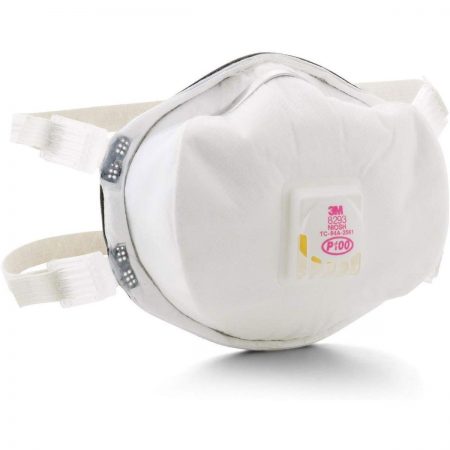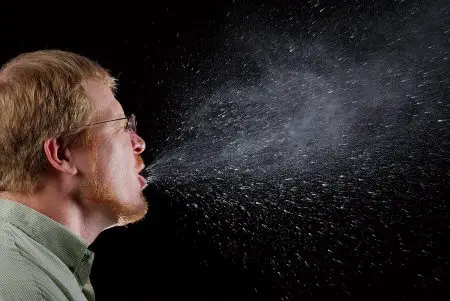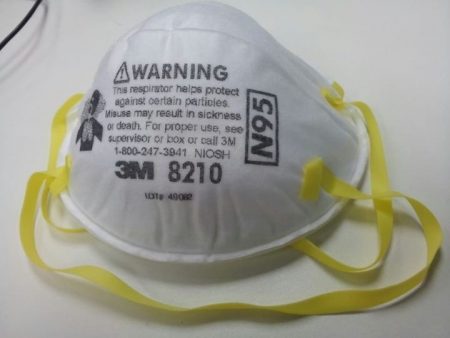Difference Between an N95 Mask and a Surgical Mask
A lot of people are trying to figure out what the difference is between an N95 mask and a surgical mask. What do they protect against? How long can you use them? It can all be pretty confusing!
An N95 mask is a respirator that removes 95% of particulates that are .3 microns and larger. This includes bacteria and viruses. A surgical mask protects the wearer from splashes of blood and bodily fluids and protects others from diseases that the wearer may have. It does not protect against bacteria or viruses.
If you’re going to be within 6 feet of someone that may have an infectious disease, then you should be wearing an N95 mask. If you have the disease then you should be wearing a surgical mask. Make sense?
Keep reading to get all the information you need about N95 and surgical masks.
[wc_toggle title=“Table of Contents” padding=“” border_width=“” class=“” layout=“box”]
[/wc_toggle]
[wc_box color=“inverse” text_align=“left” margin_top=“” margin_bottom=“” class=“”]
Thanks for supporting Ready Lifestyle! We participate in the Amazon associates program and other affiliate programs. We earn a small commission on qualifying orders at no expense to you.
Surgical Masks
Surgical masks are mainly used by doctors and other healthcare professionals to protect them from drops of blood and other bodily fluids. They also protect others from any large droplets of bodily fluid that may come off of the wearer.
You can see why it makes sense for people in the medical community to wear them, but does it make sense for other people to wear surgical masks to protect them from diseases they may come in contact with?
Do surgical masks keep out germs?
Surgical masks don’t keep germs out! They just aren’t designed to prevent small airborne contaminants from making it into the wearer’s mouth and nose.
The small particles (not visible to the naked eye) can get in straight through the mask or around the sides of the mask because they aren’t designed to seal tightly on the face.
Simply put, surgical masks will not keep you from getting sick, but they can keep other people around you from getting sick.
In the U.S., only masks certified from the Food and Drug Administration have been tested to stop blood and bodily fluids. Make sure the FDA signed off on any surgical masks you buy.
How often should surgical masks be changed?
Surgical masks aren’t meant to be worn for long periods of time. Once they get moist they lose a lot of their ability to stop the spread of diseases.
Change out surgical masks once they’re moist, come in contact with human bodily fluids, or in between patients if you happen to be treating people. At a minimum, change them out at least every day.
Can I reuse a surgical mask?
Surgical masks aren’t made to be used more than once.
Don’t re-use, share or try to wash surgical masks. Throw them away in a lined garbage can and dispose of them with your other trash.
Is it bad to wear a surgical mask all day?
There’s nothing specifically bad about wearing a surgical mask for a whole day. The problem comes when the mask gets wet. At that point, it gets a lot more likely that it won’t be as protective as you expect it to be.
N95 Masks
The N95 mask is a NIOSH approved respirator designed to capture 95% of all particles that are larger than .3 microns. They’re mainly used by people that work in environments with a lot of airborne particles that can be harmful to the lungs. Medical professionals use them to limit the chances of inhaling airborne viruses and bacteria.
The main difference between surgical masks and N95 masks is the fact that N95 masks are actual respirators. This means they are designed to filter the air you breathe. Surgical masks are there mainly to keep fluids from coming out of your mouth and onto someone else or preventing fluids from someone else from getting into your mouth.
Proper Fit of the N95 Mask
In order for an N95 mask to work correctly, you need to make sure that it fits you properly. When you breathe in all of the air should be sucked through the mask itself and not come in around the sides of the mask.
If air is coming in around the sides of the mask, then it’s not being filtered and you are being exposed to whatever it is that you’re trying to protect yourself from! Make sure that you tighten the elastic straps on the mask to get it as secure as you can.
N95 masks come in several sizes, so try a couple out to see which one fits you the best and gives you the best seal. They also come in different styles so you may find that one style doesn’t really work with the shape of your face, but another style fits great. Go with the mask that fits you the best.
FDA Approved N95 Masks
Some N95 masks that you find will be FDA approved on top of being NIOSH approved. This just means that they have been tested by the FDA to adequately stop fluids from getting through them and have been tested for flammability.
This style of mask is a medical-grade N95 mask. Other than being tested for those two things, they work the same way as other N95 masks. You don’t need an FDA approved N95 mask to protect yourself from illnesses.
What does the N in N95 stand for?
The N in N95 means that the mask isn’t resistant to oil. Other masks are designed to stand up to airborne oils and they have an R or P in front of the 95. I’ll touch on P95 and R95 masks at the end of the article.
What is the thing on the front of some N95 masks?
You probably noticed that some N95 masks have a small plastic thing on the front of them. This is just an exhalation valve.
It’s meant to decrease the resistance when you exhale to make breathing in the mask a little easier. I find that they help to keep moisture from building up inside the mask and make it more comfortable to wear for a long time.
The good thing is you don’t need one! If you have a mask with one, then great. If you don’t, it isn’t going to change the level of protection that you’re getting from the mask.
Are N95 masks reusable?
Technically, N95 masks are reusable until they become deformed, dirty or difficult to breathe through. This is great advice if you’re wearing the mask to protect you from dust and other things that can get into your lungs and cause problems.
Does that make sense for preventing the spread off disease? Not really.
If you’re wearing an N95 mask to prevent you from getting a disease then you should really get rid of it after you wear it.
Think about it this way. The mask that you’re wearing is stopping all of the potentially infected droplets that other people are coughing and exhaling around you.
It’s great that you didn’t breathe those droplets in, but now they’re on the outside of that mask. The outside of that mask is now contaminated. Do you really want to take that mask off, save it for later, and put it back on your face?
Here are a few tips for wearing an N95 mask:
- Never try to wash an N95 mask
- Don’t wear it if it’s deformed, overly dirty, or difficult to breathe through
- Always make sure that you have a good seal around the sides of the mask
- If you’re wearing the mask to protect from disease, throw it away after wearing it and wash your hands after you touch it
Other Types of Masks
There are tons of other types of masks out there that you’ll probably end up seeing if you go looking for an N95 mask. Knowing what you’re looking at will make buying masks a lot less confusing.
[wc_box color=“primary” text_align=“left” margin_top=“” margin_bottom=“” class=“”]
Interested in learning about gas masks? Check out our article that tells you everything you need to know about gas masks.
R95 and P95 Masks
R95 and P95 masks are designed to be used where there are oil particles in the air. They both still filter out 95% of the junk that bigger than .3 microns in size.
R95 masks are good for about 8 hours in an oily environment and P95 masks can go for 40 hours. That’s the only real difference.
If you’re looking for N95 masks and can only find R95 or P95 masks then you can buy them and they’ll be just as good as an N95 mask!

N100 and P100 Masks
N100 masks are basically the same as an N95 mask except they filter out nearly 100% of all particles over .3 microns. P100 masks do the same except they’re designed for oily environments.
Are they better than N95 masks? They do provide a little more protection so yes, but most people will be just as well off with an N95 mask.
Conclusion
Remember, surgical masks are for those people that have the disease, and N95 masks are for those people that are trying not to get the disease. If you know that, then you know about as much as you really need to know about the difference between the two types of masks.
Remember the other types of masks out there! People may rush to buy all the N95 masks they can find if there is some kind of scare about a disease, but they probably won’t know what a P95, R95, N100 or P100 mask is. These could still be in stock when all of the N95 masks are long gone.
Difference Between an N95 Mask and a Surgical Mask is available on: Ready Lifestyle
Difference Between an N95 Mask and a Surgical Mask published first on https://readylifesytle.tumblr.com



Comments
Post a Comment